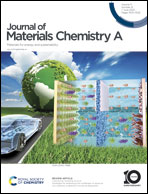Understanding the origin of the wide voltage window of microporous carbon electrodes with oxygen-containing defects by modulating surface chemistry†
Abstract
Nanoporous carbon has been demonstrated to be a great candidate as an electrode material in the applications of electrochemical double-layer capacitors (EDLCs). Although, tremendous efforts have been devoted to the molecular-level understanding of the micropore (<1 nm)/electrolyte EDLs, many mechanism details for explaining electrochemical performances still remain unclear. A typical example is that there is no explanation for the wide operating voltage window of the micropore electrode with O-containing defects in aqueous electrolytes (e.g. NaCl and Na2SO4) as reported. Here, we have employed ab initio molecular dynamics simulations on micropore (1.1 nm)/electrolyte interfaces to unravel the influence of this kind of carbon surface chemistry. We confirmed that the C–O–C structure at the edge of pores affects the dynamic process of ion adsorption as well as the formation of the EDL structure. In addition, we find that the Na+–O interaction leads to a non-negligible interfacial charge transfer, contributing to a specific electrical response at the interface. It was clear that water molecules in the EDL interface have strong hydrogen-bonded structures and thus lose the hydrogen evolution reaction (HER) activity. We further discussed the effect of pore size on the broadening voltage window and found that both larger and smaller pores would have negative effects due to the change in EDL structures. Our work provides valuable insights into the effect of O-containing defects on broadening voltage windows and is an effective way to obtain porous carbon-based EDLCs with great electrochemical performances by modifying carbon surface chemistry.



 Please wait while we load your content...
Please wait while we load your content...